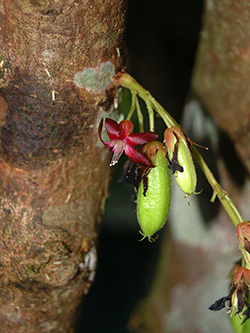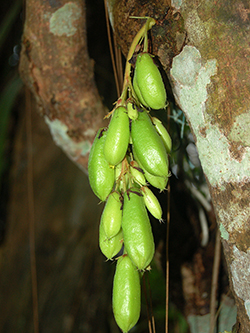e-Flora of Thailand
Volume 2 > Part 1 > Year 1970 > Page 22 > Oxalidaceae > Averrhoa
2. Averrhoa bilimbi L.wfo-0000557404
Sp. Pl.: 428. 1753; Edgew. & Hook.f., Fl. Br. Ind. 1: 439. 1874; Ridl., Fl. Malay Penins. 1: 331. 1922; Craib, Fl. Siam. En. 1: 207. 1926; Knuth in Pflanzenr. 95: 418. 1930; Back. & Bakh. f., Fl. Java 1: 247. 1963.
Accepted Name : This is currently accepted.
Description : Shrub or tree, up to 15 m; branches erect. Leaves 7–19-jugate, usually teminally tufted; rachis 17–60 cm; leaflets up to 12 by 4 cm, underneath tomentose to puberulous, not glaucous, lowest reflexed. Panicles cauliflorous down to ground level, rarely axillary, up to 20 cm. Pedicels 4–17 mm, articulate near the middle. Petals 10–20 by 3–4 mm, distinct, glabrous inside. All stamens with anthers. Ovules 4–7 per cell. Berry up to 10 by 5 cm, terete-obtuse-angular in cross-section. Seeds exarillate.
Thailand : NORTHERN: Chiang Mai; CENTRAL: Krung Thep Maha Nakhon (Bangkok); PENINSULAR: Yala (Bannang Sata).
Distribution : Native country unknown (E Malesia?) (type from Ceylon), cultivated, often a relic of former cultivation.
Ecology : Along rivers, in primary and secondary forests.
Vernacular : Taling pling (ตะลิงปลิง).
Uses: In Malesia the leaves are used as a paste against itches, eaten against syphilis, and a decoction is drunk after childbirth. In Jana the leaves are used against mumps, rheumatism, pimples, and piles; a decoction of the flowers is also used against cough and thrush. The fruits are eaten fresh or pickled, but are more acid than those of the preceding species. The juice is generally used against fever, scurvy, beri-beri, biliousness, coughs, and piles; it also removes stains from laundry, hands, and weapons.


